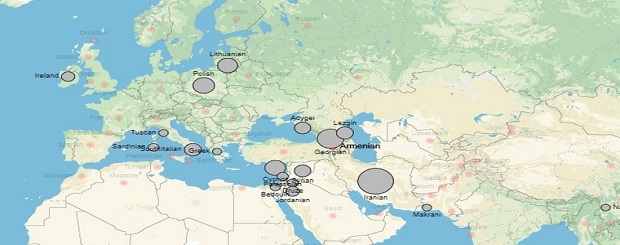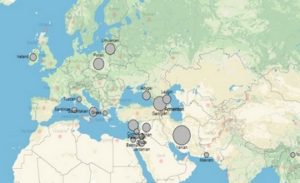
January 9, 2019 – Vigen Avedisyan – Genetics.

The Armenians are an ancient people of the Near East who demonstrate a genetic affinity with the peoples of Europe, as well as the Middle East and the Caucasus. This is stated in an article published in the European Journal of Genetics.
Studying genetically isolated groups allows you to take a fresh look at history. The examples of Druze, Jews, and Christians of the Middle East show that the population of the region was genetically stronger connected with Europe 2,000 years ago than it is now.
In this work, the Armenians are studied – the people who are now limited to the Caucasus but who used to occupy Eastern Turkey up until the Mediterranean before the events of the early 20th century.
Before, the genetics of Armenians had been studied very little at the level of several samples. Now, the genetic affinity of this nation to some others is clear, including Jews, Druze, and Lebanese Christians, as well as to the Caucasian peoples.
This study analyzes the data of the Armenian genome and compares it with known samples from 78 other groups. The emergence of Armenians as an ethnic group, as well as the changes in the cultural and ethnic palette of the Middle East were also studied.
Genetic samples were collected from Armenians from Lebanon and Armenia. Armenians from Lebanon had originated in Eastern Turkey.
According to the observations of the scientists, Armenians make up an easily distinguishable group bordering the Europeans, peoples of the Middle East, and Caucasians. In Europe, Armenians are closer to the Spaniards, Italians, and Romanians, in the Middle East – to the Lebanese, Jews, Druze, and Cypriots, in the Caucasus – to Georgians and Abkhazians.
The position of the Armenians on the genetic map mirrors the position of Turkey. In previous studies, Turks were usually regarded as genetic representatives of the ancient peoples of Turkey. The results of this study show that Turks are genetically closer to the peoples of Central Asia, which corres
ponds to the history of ethnic contacts in the region.
Tests show that Armenian genomes bear traces of ethnic mixtures. Their time frame coincides with the time of the legendary founding of Armenia in 2492 BC. After the fall of the Bronze Age Mediterranean civilizations around 1200 BC, the signs of admixtures in Armenians sharply decrease. Apparently, the collapse of other nations caused the isolation of Armenians from their neighbors. The uniqueness of their culture, language, and religion are a result of this isolation.
Impurities in Armenians are similar to those seen in other more ancient isolated groups of the region like Sephardic Jews and Lebanese Christians. According to studies, Armenians haven’t mixed in significant proportions with other nations since the end of the Bronze Age. That is, for 3,000 years.
The affinity of Armenians with other isolated groups in the Middle East – but to the minority of other peoples in the region – suggests the latest admixtures significantly changed the genetic landscape of the Middle East which in ancient times had more genetic affinity with Neolithic Europe than now.
The importance of studying Armenians isn’t just limited to the study of ancient demographic processes. Isolated nations are becoming a valuable source for genetic research. The long isolation of Armenians could have caused the appearance of rare disease alleles, a subject that should be further explored.
See also the Genetic Atlas: admixturemap.paintmychromosomes.com
According to research of www.nature.com

allinnet.info/genetics/armenians-are-genetically-close-to-the-nations-of-europe-european-journal-of-genetics/
